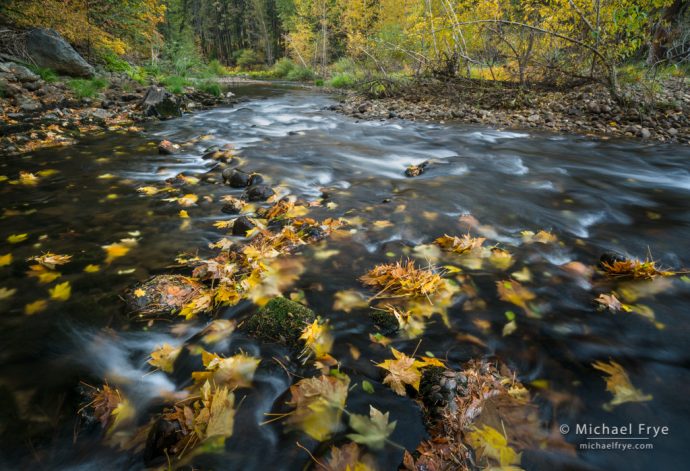
Big-leaf maple leaves along the Merced River, autumn, Yosemite. 19mm, 2 seconds at f/16, ISO 100, polarizer.
Claudia and I spent Friday in Yosemite Valley checking out the fall color. And it was beautiful. The big-leaf maples, in particular, were quite colorful.
It was a clear, sunny day, so there wasn’t any weather to add drama to the valley landscapes. When the weather and light aren’t that interesting I tend to narrow my focus and photograph smaller subjects. And for those subjects, conditions were perfect. The low autumn sunlight kept some parts of the valley in shade virtually all day, and that soft light was perfect for highlighting the autumn color. Plus, from the south side of the Merced River you could look toward sunlit cliffs on the north side of the valley and find beautiful, golden reflections in the shaded water.
I spent most of my time in the west end of the valley, looking for intimate scenes of fall color along the river. Trees can be beautiful by themselves, but there’s something about water that can add an extra dimension to a photograph. We’re drawn to water; put a human being near a lake, river, or ocean, and they will move toward the water instinctively, like a moth toward light. And visually, water moves, and shimmers, and creates reflections. It’s wonderful stuff.
As I wrote last year, lately I’ve been using wide-angle lenses more often for intimate landscapes. It can be challenging to keep compositions simple and clean when using a wider lens. But when you can make it work, using a wide-angle lens with intimate landscapes can create a sense of depth, which helps to immerse the viewer in the scene, and create a stronger emotional connection with the photograph.
Of course I used a variety of lenses on Friday. I chose whatever focal length made the strongest composition for the situation at hand, and would tell the story I wanted to tell. So the accompanying photographs were made with lenses from 19mm to 200mm, and everything in between.
As I said, the big-leaf maples were beautiful on Friday; about 90% were yellow, with a few bare trees and a few still green or partially green. The other deciduous trees were decidedly mixed. Most of the dogwoods were partially turned – a mix of green and either yellow, gold, or red. They’re further along and more colorful at higher elevations, like along highways 41 and 120, and in the Tuolumne Grove. The dogwoods in Yosemite Valley should look better in another week or two. The cottonwoods were also still showing a lot of green leaves, along with quite a few brown ones, but there were some that had turned yellow. The cottonwoods may get better over the next week or two as those green leaves turn yellow, but it’s just not a great year for them.
Unfortunately, it’s not a great year for the black oaks either. Almost all their leaves have turned brown. Only a few oaks have normal-looking green or gold leaves. I’m not sure why the oaks had this response after a record-setting year for precipitation. Maybe they got too much water after five years of drought?
So this means it’s a typical autumn in Yosemite Valley. Since there are four main species of deciduous trees with autumn color, and they all seem to have different reactions to the weather, the fall color is usually quite a mix. Maybe once every ten years or so all four species have good color, and all turn at the same time. But most years at least one species has a poor year for color. And even when they all have good years they usually peak at different times.
The big-leaf maples are probably the most consistent autumn performers. They’re usually the first trees in Yosemite Valley to turn, and rarely have an “off” year. They were beautiful on Friday, and with the warm weather we’re having they should stay colorful for maybe another week before the leaves drop off. By then perhaps the dogwoods will be looking better.
— Michael Frye
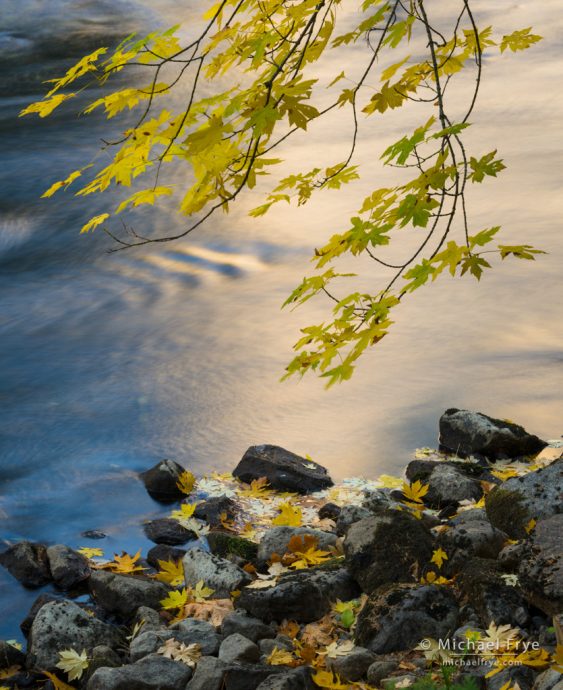
Big-leaf maple branches hanging over the Merced River, autumn, Yosemite. 100mm, 6 seconds at f/16, ISO 50, 4-stop ND filter.
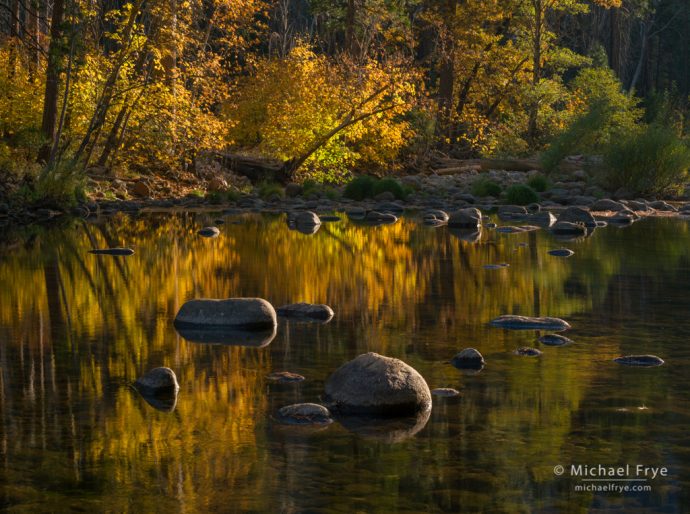
Late-afternoon light along the Merced River, autumn, Yosemite. 70mm, 1/6 sec. at f/16, ISO 100, polarizer.
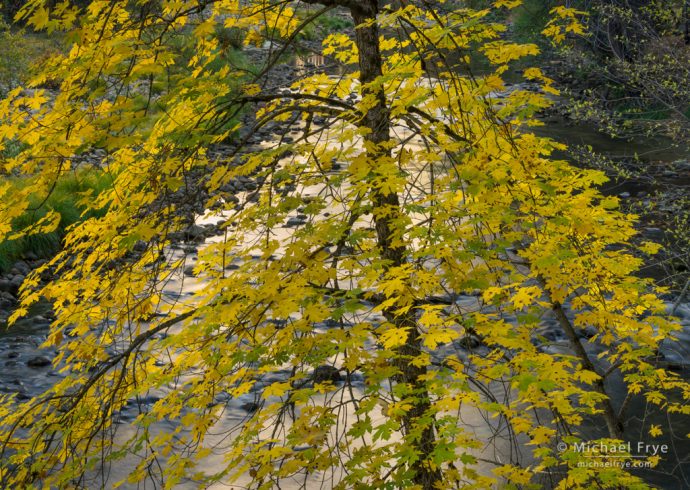
Big-leaf maple and the Merced River, autumn, Yosemite. 70mm, 6 seconds at f/16, ISO 50, 4-stop ND filter.
Related Posts: Intimate Landscapes with Wide-Angle Lenses; Light and Mood With Intimate Landscapes
Michael Frye is a professional photographer specializing in landscapes and nature. He is the author or principal photographer of The Photographer’s Guide to Yosemite, Yosemite Meditations, Yosemite Meditations for Women, Yosemite Meditations for Adventurers, and Digital Landscape Photography: In the Footsteps of Ansel Adams and the Great Masters. He has also written three eBooks: Light & Land: Landscapes in the Digital Darkroom, Exposure for Outdoor Photography, and Landscapes in Lightroom: The Essential Step-by-Step Guide. Michael has written numerous magazine articles on the art and technique of photography, and his images have been published in over thirty countries around the world. Michael has lived either in or near Yosemite National Park since 1983, currently residing just outside the park in Mariposa, California.

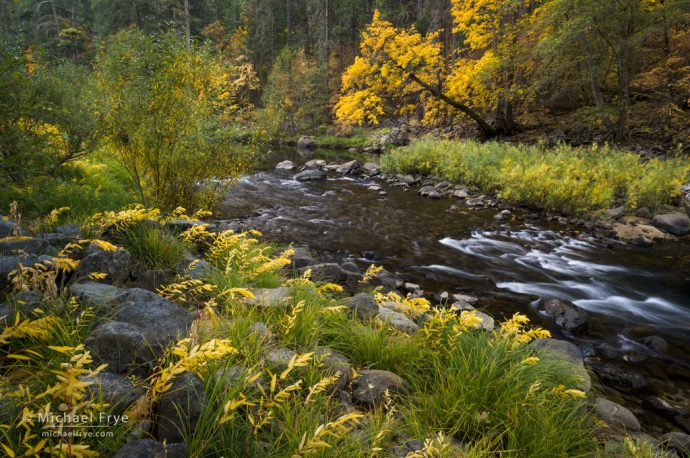
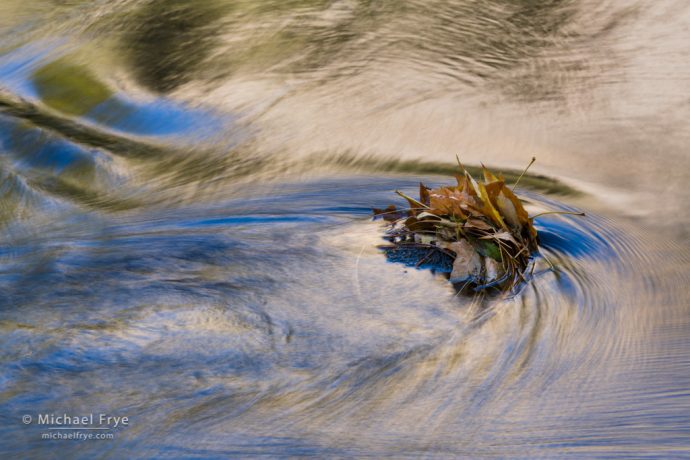
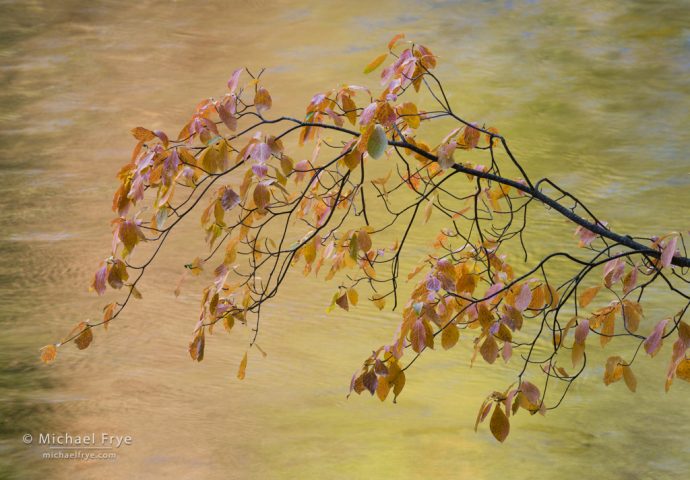








Beautiful work as always, Michael. Soft light, lovely reflections, and judicious use of the shutter have combined to bring us an exquisite group of “Intimate Landscapes.”
Such an eye you have.
Anton Neilson.
Thanks Anton!
Those colors are beautiful Michael. Do I understand from your comments and the photos that you use a polarizer for shots in the shade too?
Your tempting me to make quick trip up there in the next week or two.
Thanks John. I sometimes use a polarizer for photos of vegetation in the shade, as the polarizer will cut shiny reflections on leaves. But in the photos, when I used a polarizer it was mainly to cut reflections on the water.
Ah, OK, that makes sense. Thanks.
Beautiful, Michael. And I’m headed for the Valley tomorrow, so what a perfect time for your guidance!
Thanks Mike! Hope you have a good time.
Love the variety of light.
Most captivating for me were:
“Big-leaf maple branches hanging over the Merced River, autumn”
Almost Asian-like and surreal at the same time
and
“Big-leaf maple leaves in the Merced River, Yosemite”
The latter looked like some ancient very-weathered vessel navigating the universe. Stunning image.
– A
Thanks so much Andrys!
They are all so beautiful! My favorites are the top image and the two closeups of the maple leaves and silky-smooth water. Feasts for the eyes!
Thanks Bev!
Thanks, so much, Michael, for these beautiful images of Yosemite in the fall. I love these intimate compositions—looking at your images always helps me learn more about landscape composition. I am in the U.S. for a brief trip to see a close family member who is failing. I spent a week with my family in Plumas County and despite the emotion, was able to enjoy the spectacular fall colors there. All best to you—Bob.
Thanks Bob, and all the best to you and yours.
Superb.
Thanks Sunil!
Thanks for the inspiring images. I’m visiting Yosemite next week for the first time in my life and these help set the mood. I’ll also be armed with your beautiful Yosemite meditations book. Can’t figure out the weather: one forecast says sunny with highs around 60 and lows in the 30s, while another says overcast with highs in the upper 20s and lows around 0. Go figure.
You’re welcome Mike. I’m guessing you’re using some kind of app or apps for the weather, and many of those weather apps give crappy forecasts for Yosemite. They use the forecast for the nearest major city or town, which could be Merced – 4,000 feet lower than Yosemite Valley – or Mammoth Lakes – 4,000 feet higher than Yosemite Valley. I use the National Weather Service website, which is much more accurate:
http://forecast.weather.gov/MapClick.php?lat=37.72836644908416&lon=-119.6136474609375&site=hnx&unit=0&lg=en&FcstType=text#.WfdteUzMyEI